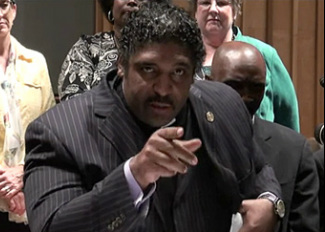 Reverend Dr. William J. Barber Tags: crime/law/deviance, discourse/language, inequality, intersectionality, knowledge, lgbtq, marriage/family, prejudice/discrimination, race/ethnicity, sex/sexuality, social mvmts/social change/resistance, theory, civil unions, collective action frames, marriage equality, same-sex marriage, 00 to 05 mins Year: 2011 Length: 4:24 Access: YouTube Summary: In Part I we explored the concept of a collective action frame in the context of the vote on North Carolina's Amendment One, which defines marriage as between one man and one woman. Reverend Dr. William J. Barber argues in this clip that the amendment passed because the wrong frame dominated the public understanding of the issue. In Part II we want to further interrogate Barber's own frame, which posits that the amendment writes discrimination into the state constitution. We think Barber’s argument draws on key insights from intersectionality theory in sociology. In short, this theory draws attention to the relationships among multiple dimensions of social inequality (e.g., race, sexuality, gender, etc.) and insists that the formation of any subject happens at the intersections of these dimensions. Similarly, systems of domination, such as racism and heterosexism, work through this invisible, intersectional scaffolding. Echoing an insight from Kimberlé Crenshaw's path breaking article on the theory, the failure of antiracism to interrogate heterosexism means that antiracist activists are doomed to reproduce the subordination of racial minorities in the LGBTQ community. Indeed, this is what might very well have happened in North Carolina. In the lead up to the vote on Amendment One, it is now clear that there was a coordinated strategy from a political group calling itself the National Organization for Marriage. The group aimed to drive a wedge between members of LGBTQ and Black communities (here and here). Recently unsealed memos from the group state clearly that “The strategic goal of the project is to drive a wedge between gays and blacks” and another memo noted the group's aspirations to make the exclusion of gay people from marriage “a key badge of Latino identity.” Barber's frame, then, grasps the way racial and sexual identities were strategically pitted against each other in the vote on Amendment One, but his frame also grasps that violations of equal protection under the law for members of the LGBTQ community in this instance, leaves the door open for violations against racial minorities in the next. As illustrated in this moving speech, intersectionality theory, not only describes how political power relies on manipulating social constructed racial and sexual identities, but also how political resistance must take these constructs into account when formulating effective collective action frames. Submitted By: Lester Andrist
4 Comments
M Weinstein
10/24/2012 07:52:47 am
Could you check the link to Crenshaw's article.
Reply
Manuel Franco
7/30/2023 11:54:09 am
I just want to say Thank You to everyone who supported me through the years. My name is Manuel Franco, New Berlin, Wisconsin. My story of how I won the Powerball lottery of $768.4M is a bit of a tale. I have been playing Powerball tickets for 6 years now since I turned 18. I bought my first ticket on my 18 birthday. I was feeling very lucky that day because I had contacted Dr. Odunga Michael to help me with the winning Powerball numbers. I really had that great great feeling that I looked at the camera wanting to wink at it. I only did a tiny part of it and trusted him. He gave me the numbers after I played a couple other tickets along with it for $10. I checked my ticket after the winnings came online and saw the numbers were correct including the Power play. I screamed for about 10 minutes because it felt like a dream. I had won $768.4M. You can check my winning testimony with the lottery officials just with my name search. Thank you Dr Odunga. Well, his email is [email protected] and you can also call or Whats-app him at +2348167159012 so you guys can contact him
Reply
mark hold
7/8/2024 07:45:57 am
Herbal Penis Enlargement product is 100% guaranteed to Enlarge and get a better ERECTION, the reason why most people are finding it difficult to enlarge Penis is that they believe in medical reports, drugs and medical treatment which is not helpful for Penis Enlargement. Natural roots/herbs are the best remedies which can easily Enlarge your Penis permanently Contact Dr MOSES BUBA via Email: [email protected] or via WhatsApp: +2349060529305. for Natural root and herbal remedies put together to help Enlarge manhood and Erect healthily. I also learn that Dr MOSES BUBA also can cure other types of diseases, HEPATITIS B,DIABETICS,CANCER,HPV,LOW SPERM CAM, HIV/STDS, FIBROSIS LOST OF WEIGHT, BREAST ENLARGEMENT, HIPS and BUMS ENLARGEMENT etc .
Reply
Leave a Reply. |
Tags
All
.
Got any videos?
Are you finding useful videos for your classes? Do you have good videos you use in your own classes? Please consider submitting your videos here and helping us build our database!
|
 RSS Feed
RSS Feed
